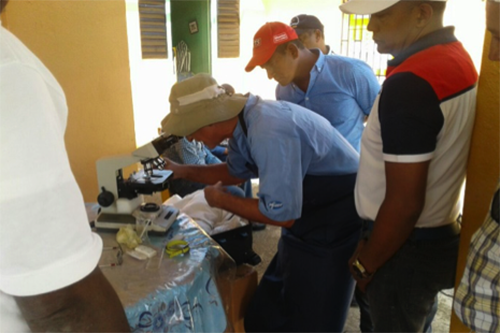For small livestock farmers in the Dominican Republic, the fertility of the only bull on their farm could mean the success or failure of their business. When buying a bull, Dominican farmers usually look for the best genetic characteristics—those that will yield more productive results: cows that produce more milk if it’s a dairy farm and bulls that produce more and better quality of meet if it’s a beef farm.
However, most farmers do not conduct reproductive, or andrological, evaluations before buying a bull, which means they buy a bull without knowing whether or not it’s fertile. The U.S. Department of Agriculture (USDA)-funded Safe Agriculture and Food Export (SAFE) project implemented by NCBA CLUSA in the Dominican Republic is helping to create awareness of the importance of bull evaluations by conducting evaluation tours with andrological specialists Dr. Jorge Mario Bolaños and Dr. Juan Francisco Campechano.
Bull reproductive evaluation sessions have already been carried out in five of the 11 provinces of the project, where they have yielded alarming results: on average, 59 percent of bulls were found not suitable for reproduction. A bull that is categorized as not suitable for reproduction during an andrological examination must be thoroughly evaluated to determine the cause. Many times the root cause of infertility can be treated or solved, as in the case of an infection, poor nutrition or heat stress.
Without the presence of a fertile, healthy bull, the pregnancy rate on a farm can fall drastically and livestock activity may become unprofitable. For example, if the owner of a 25-cow farm buys a bull at $2,000 USD, given feeding costs and compared to the price the farmer will eventually sell the bull for meat, a farmer could potentially lose $5,500 over three months with an infertile bull. In response to these results, the Agricultural Bank of the Dominican Republic has announced that, going forward, it will only finance bulls that have had reproductive evaluations.
Understanding fertility can help farmers make better investment decisions when buying bulls.The reproductive evaluation of bulls includes three steps: a behavior evaluation, physical evaluation and laboratory evaluation. In the bull evaluations conducted by the SAFE project, a portable microscope means the laboratory results can be seen immediately on the farm.
There are several factors that can affect the result of the andrological evaluation of a bull, including some easily remedied issues such as poor nutrition or an underage bull. Other reasons include more permanent issues; understanding the difference can help farmers make better investment decisions when buying bulls.
The alarming results of the recent bull evaluations have impacted farmers who previously had not conducted any kind of professional evaluation before buying a bull and would generally make decisions based on aesthetics or the reputation of a bull’s family genetics. With new information, they can make decisions about their herds that may not be immediately clear through observation alone.
Miguel Ceballos, a livestock farmer whose bulls were recently evaluated, is now an advocate for regular andrological evaluations. Because his dominant bulls were being territorial during breeding season, Ceballos assumed they were producing viable sperm. When the test results came back negative, it was too late to do anything about it; breeding season was almost over.
“Don’t you think that if I would have known this at the beginning [of breeding season] it would have been beneficial for me? After this experience, I prefer to evaluate [my bulls] at least once a year,” he said.
During the evaluations, the SAFE team takes the opportunity to speak to the farmers about animal genetics, emphasizing the need to use breeds that are suitable for the Dominican Republic climate and the need to compliment genetic improvement with optimum nutrition to ensure productivity on the farm.



